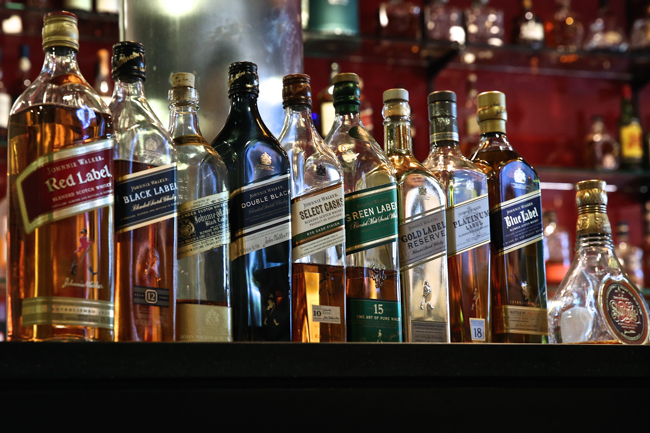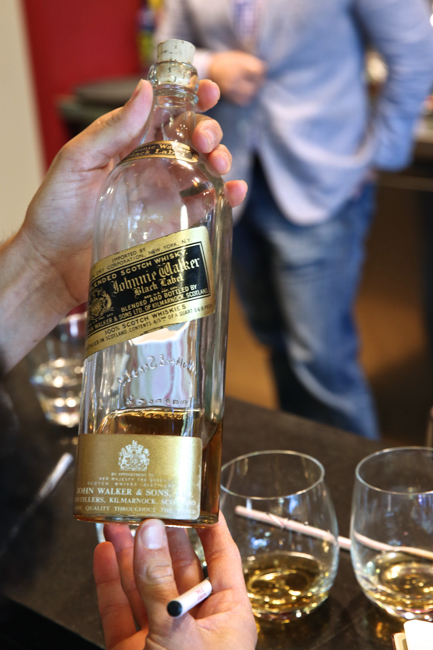Revisiting Johnnie Walker

As any savvy shopper knows, it's not easy to find value in a market where everyone's searching for the same thing. We always have to laugh when a customer says something like, "I really like Willett 20 year and Jefferson's 18, but I want to keep it around twenty bucks. Do you have any recommendations?" When no one was drinking Bourbon there was serious value to be found in some of the more mature expressions. Now it's a different story. Ditto for single malt whisky. In the case of blended whisky, however, it's an interesting scenario because it's never been less popular with whisky sophisticates, but it's still the majority of what people drink. Marketing in any category tends to search for ways to send prospective shoppers over to more plentiful pastures, much like what we've been trying to do with our Armagnac and Cognac discoveries. That's what happened a decade ago when the industry began pushing single malts over blends. "You want the pure stuff with an age statement, not that blended slop with grain added," we were told by ambitious brand ambassadors. And the messaging worked! Now, however, with a supply chain that's been gutted, age statements a recent memory, and prices at all-time highs, single malt seems like less of a value proposition. It's because of those recent developments that I've been itching to go back through some of the standard blended portfolios and do a little pound-for-pound comparison against some of the more popular single malts. Since age-stated blends are typically cheaper than their single malt brethren, maybe there's more value to be had on that side of the market currently. It's been long overdue in finding out. What better place to start than with Johnnie Walker?

Luckily for myself and the K&L staff, our San Francisco store is just a hop, skip, and a jump from Diageo's new downtown tasting bar—a secret location set up for training the region's finest bars, restaurants, and retailers. I gathered the spirits crew—Kyle, Andrew, and Jeff Jones—and we headed over to the heavily-guarded hotspot. There to meet us was Diageo's new "Master of Whisky" Todd Richman who was incredibly well-versed on the Walker brand's history and its many particularities. We went through the full gambit—Red, Black, Double Black, Green, Platinum, Blue, as well as a number of one-offs—and I have to say we were all thoroughly impressed with our findings. Not one of us had tasted Walker Red in more than a decade and—I have to be honest here—I was quite taken aback by the quality. The richness, maltiness, balance of flavors, and pleasing finish were completely unexpected, especially for a mark that sells tens of millions of cases a year. "There are more than a billion people drinking Johnnie Walker Red around the world," Todd added at one point. No shit. I can see why. In a craft market that continues to up the price ante for one and two year old experiments (that may or may not even taste good), it's easy to get behind something incredibly satisfying with incomparable consistency that runs you about twenty bucks a bottle no matter where you go.

Todd was super generous in his offerings as well, pulling out antique versions of some of the main Walker expressions (like this Black Label from the 1950s) so that we could taste how the styles have evolved over the years. What I found most interesting, however, was how diverse our reactions were in response to our favorites. I gravitated towards the Platinum with its chewy, sherry-influenced palate; a surprising choice considering I wasn't a fan when the product was first introduced to the market. Either it's changed since then, or I have. Andrew thought the Red was simply too good for the money. Kyle enjoyed the rye-finished Select Cask most of all, and Jeff I think went with the standard Black Label. As Todd mentioned throughout the afternoon, Diageo's primary agenda is the consistency of quality throughout its Johnnie Walker portfolio, even if it means some of their single malt expressions suffer as a result. They'd rather run out of Caol Ila 12 and Clynelish 14 if it means keeping the various flavor profiles of the Walkers intact.
As we left the appointment and walked down Battery Street under the sunny San Francisco sky, we asked one another: if the new age of limited edition single malt whisky is being marketed to drinkers who want to feel unique or special, then who's the target audience for Johnnie Walker? My response was: "It's for people who are comfortable enough to know what they like, to know what tastes good, and don't need to prove much of anything beyond that." Blended whisky seems like more of the value proposition these days, so long as you're fine with blending in.
-David Driscoll
